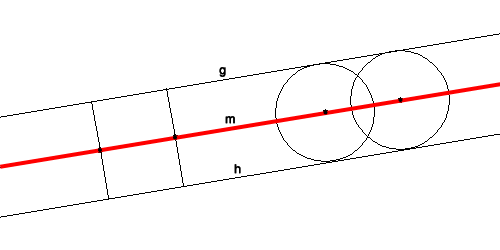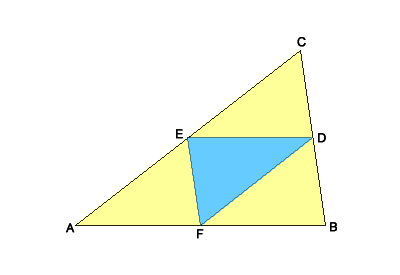Central parallel
The term central parallel is used in several meanings in geometry .
Central parallel of two straight lines
If there are two parallel straight lines g and h, then their central parallel is the straight line that is equally spaced from g and h . This is the most commonly used meaning.
Illustration: The median of a straight country road basically represents a central parallel between the edge of the road.
The central parallel is the geometrical location (the set) of the centers of all circles that touch the given straight line, and the geometrical location of all points that are at the same distance from the two straight lines, compare bisector .
Center parallels of a triangle
The links of the side center points of a triangle is referred to as the agents parallels (or also called center lines ) of the triangle, because it to one side of the triangle in each case parallel are. Each of these central parallels is half as long as the corresponding side of the triangle. ( Theorem of the median parallel in the triangle )
The three agents parallels a triangle form the so-called middle triangle . It is similar to the original triangle .
Central parallel of a trapezoid
The central parallel of a trapezoid is the connecting line between the central points of the two sides that are not necessarily parallel. This stretch is parallel to the two parallel sides (base sides) of the trapezoid.
The length of the central parallels results from the arithmetic mean of the lengths of the two base sides:
With the help of the central parallel of the trapezoid, the trapezoidal area can also be calculated. To do this, multiply the length of the central parallels by the height of the trapezoid, i.e. H. the distance between the two parallel base sides.
literature
- Hans Schupp : Elementary Geometry . Schöningh, Hannover 1977, ISBN 3-506-99189-2 .
- IN Bronstein , KA Semendjajev , G. Musiol, H. Mühlig (Hrsg.): Taschenbuch der Mathematik . 7th, completely revised and expanded edition. Verlag Harri Deutsch , Frankfurt am Main 2008, ISBN 978-3-8171-2007-9 .




